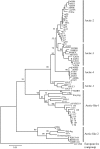Arctic and Arctic-like rabies viruses: distribution, phylogeny and evolutionary history
- PMID: 17599781
- PMCID: PMC2870842
- DOI: 10.1017/S095026880700903X
Arctic and Arctic-like rabies viruses: distribution, phylogeny and evolutionary history
Abstract
Forty-one newly sequenced isolates of Arctic and Arctic-like rabies viruses, were genetically compared to each other and to those available from GenBank. Four phylogenetic lineages of Arctic viruses were identified. Arctic-1 viruses circulate in Ontario, Arctic-2 viruses circulate in Siberia and Alaska, Arctic-3 viruses circulate circumpolarly, and a newly described lineage Arctic-4 circulates locally in Alaska. The oldest available isolates from Siberia (between 1950 and 1960) belong to the Arctic-2 and Arctic-3 lineages and share 98.6-99.2% N gene identity with contemporary viruses. Two lineages of Arctic-like viruses were identified in southern Asia and the Middle East (Arctic-like-1) and eastern Asia (Arctic-like-2). A time-scaled tree demonstrates that the time of the most recent common ancestor (TMRCA) of Arctic and Arctic-like viruses is dated between 1255 and 1786. Evolution of the Arctic viruses has occurred through a northerly spread. The Arctic-like-2 lineage diverged first, whereas Arctic viruses share a TMRCA with Arctic-like-1 viruses.
Figures



References
-
- Gondatti N. Travel from Markova village on the Anadyr river to Providenia Bay (Bering Strait) Proceedings of the Priamursky Department of Royal Russian Geographical Society. 1898;4:1–42.
-
- Ognev NI. Veterinary service of Yakutia, 1853–1919. Scientific Proceedings of the Yakutian State University. 1962;13:87–89.
-
- Plummer PJ. Preliminary note on Arctic dog disease and it relationship to rabies. Canadian Journal of Comparative Medicine. 1947;11:154. - PubMed
-
- WHO World Health Organization; 1990. . Report of a WHO/NVI workshop on arctic rabies. WHO/Rab, Res/90.35.
-
- Kantorovich RA. The etiology of madness in polar animals. Acta Virologica. 1957;1:220–228. - PubMed
MeSH terms
Substances
LinkOut - more resources
Full Text Sources
Medical

